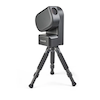User Tools
Trace:
definitions
Differences
This shows you the differences between two versions of the page.
| Both sides previous revisionPrevious revisionNext revision | Previous revision | ||
| definitions [2024/07/23 05:42] – tailspin | definitions [2024/12/31 08:28] (current) – tailspin | ||
|---|---|---|---|
| Line 4: | Line 4: | ||
| * Alt/Az Mount: An altazimuth mount is a simple two-axis mount that controls the telescope' | * Alt/Az Mount: An altazimuth mount is a simple two-axis mount that controls the telescope' | ||
| - | * Bias Frames: | + | * Bias Frames: |
| - | * Dark Frames: Images taken with the same exposure time and camera settings as your light frames, but with the lens cap on or the telescope covered. Dark frames capture the thermal noise and other electronic noise inherent in your camera' | + | * Bortle Scale: A measure of how dark your sky is ranging middle of no where to downtown Tokyo. |
| - | * Dithering: A technique where the telescope' | + | {{ :bortle_scale.jpg? |
| - | * DSO: Deep sky Object such a nebulae and galaxies, but also comets, asteroids, quasars, etc. | + | |
| + | |||
| + | * Dithering: Seestar does this automatically for you. A technique where the telescope' | ||
| + | |||
| + | | ||
| - | * Equatorial Mount: A type of telescope mount designed to counteract the Earth' | + | * Equatorial Mount: A type of telescope mount designed to counteract the Earth' |
| * [[field_rotation|Field Rotation]]: The apparent rotation of the field of view in an image caused by the Earth' | * [[field_rotation|Field Rotation]]: The apparent rotation of the field of view in an image caused by the Earth' | ||
| - | * Flat Frames: Images taken of a uniformly illuminated surface, such as a flat-field panel or the twilight sky. Flat frames are used to correct for vignetting (darkening of the image corners) and dust spots on your camera sensor or optics. Not required with the Seestar. | + | * Flat Frames: |
| * Histogram: A graphical representation of the distribution of pixel brightness values in an image. In astrophotography, | * Histogram: A graphical representation of the distribution of pixel brightness values in an image. In astrophotography, | ||
| - | * Light Frames: | + | * Light Frames: |
| * Mask: A tool used in image processing software to selectively apply adjustments to specific areas of an image. Masks can be created based on brightness, color, or other criteria, allowing you to isolate and enhance specific parts of the image without affecting the rest. Use in post-processing, | * Mask: A tool used in image processing software to selectively apply adjustments to specific areas of an image. Masks can be created based on brightness, color, or other criteria, allowing you to isolate and enhance specific parts of the image without affecting the rest. Use in post-processing, | ||
| - | * Mosaic: A large image created by combining multiple overlapping smaller images, typically used to capture wide fields of view that wouldn' | + | * Mosaic: A large image created by combining multiple overlapping smaller images, typically used to capture wide fields of view that wouldn' |
| - | * OTA (Optical Tube Assembly): The main optical component of a telescope, including the lenses or mirrors, tube, and focuser, but excluding the camera, mount, tripod. | + | * OTA (Optical Tube Assembly): The main optical component of a telescope, including the lenses or mirrors, tube, and focuser, but usually |
| * Sub frames: when the Seestar is < | * Sub frames: when the Seestar is < | ||
definitions.1721738559.txt.gz · Last modified: 2024/07/23 05:42 by tailspin
